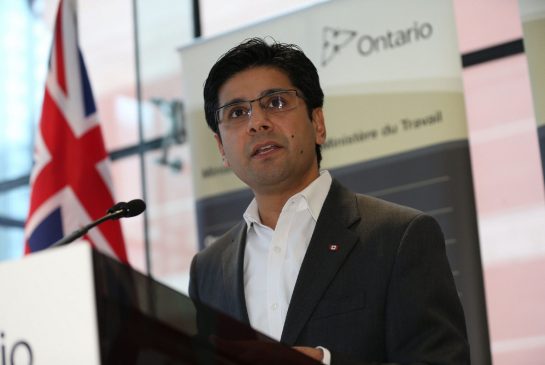>> Ontario will now assess transgender inmates based on identity, not anatomy
L’Ontario devient la première province canadienne à appliquer des règles claires pour le traitement des détenus transgenres dans ses établissements correctionnels.
La nouvelle «Politique» en matière d’admission, de classification et du placement des détenus et détenues trans est fondée sur la Loi Toby, adoptée à l’unanimité par l’Assemblée législative en 2012.
Les détenus transgenre pourront ainsi purger leur peine dans un établissement correctionnel de la province approprié à l’identité sexuelle qu’ils ont choisi. Ils pourront aussi participer au processus de choix d’hébergement et demander d’être identifiés en utilisant les noms, prénoms et pronoms personnels qu’ils souhaitent. Et, ils auront la possibilité de choisir le sexe des agents des Services correctionnels qui devront procéder aux fouilleront de façon à préserver leur intimité.
C’est «la politique la plus progressiste en son genre en Amérique du Nord pour le respect des droits humains et la dignité de tous les détenus,» selon le ministre ontarien des Services correctionnels, Yasir Naqvi.
Auparavant, les détenus étaient effectivement placés dans des institutions selon leurs «caractéristiques sexuelles premières», et les transgenres étaient le plus souvent isolés.
Ce changement survient près de 6 mois après qu’une transgenre détenue dans une prison provinciale pour hommes ait porté plainte au Tribunal des droits de la personne de l’Ontario.
Des ex-détenu(e)s étaient présents à l’annonce aujourd’hui afin de partager leur histoire avec les médias.
 Parmi eux, Boyd Kodak, qui s’identifie comme un homme. Il a été arrêté en 2012 et placé dans un centre correctionnel pour femmes : «On m’a enlevé ma prothèse pénienne. On m’a obligé à porter des vêtements pour femmes et on m’a insulté.»
Parmi eux, Boyd Kodak, qui s’identifie comme un homme. Il a été arrêté en 2012 et placé dans un centre correctionnel pour femmes : «On m’a enlevé ma prothèse pénienne. On m’a obligé à porter des vêtements pour femmes et on m’a insulté.»
Il a porté plainte au Tribunal des droits de la personne de l’Ontario et attend toujours une compensation qu’il juge adéquate.
Le chercheur à l’Université de Toronto, Kyle Kirkup, applaudit l’initiative du gouvernement, mais croit aussi qu’il faut se demander pourquoi les personnes transgenres commettent plus souvent des crimes.
Selon lui, il y a des problèmes importants de pauvreté au sein de la communauté transgenre .
Les agents des Services correctionnels recevront une formation sur la nouvelle politique en mars. Un cours en ligne de sensibilisation aux personnes transgenres sera également mis à la disposition de tous les membres du personnel du ministère de la Sécurité communautaire et des Services correctionnels.
Selon la commissaire aux droits humains de l’Ontario, Barbara Hall, c’est une politique qui va aider à protéger les droits des transgenres, plus souvent victimes de harcèlement et de violence, par les autres détenus et parfois même par le personnel.
>> Decisions on where to house Ontario’s transgender inmates won’t be based on their physical sexual characteristics but rather how they self-identify, a revised provincial policy says.
The changes, which impact the admission, placement and classification of transgender inmates, were announced at a community centre in Toronto by Ontario’s Minister of Community Safety and Correctional Services Yasir Naqvi, who told reporters one of his key priorities is protecting the human rights of these inmates.
The changes say inmates must be placed in an institution “appropriate to their self-identified gender or housing preference’’ unless there are overriding health or safety risks.
The revised policy is “the most comprehensive policy in Canada for respecting the human rights-related needs of trans individuals in correctional institutions,’’ Naqvi said in his announcement.
“We imposed our stereotypes as to the person’s identity or gender. We’ve (now) changed that completely’’ Naqvi told reporters later.
The change comes after a series of high-profile cases involving transgender accused, including the launching of a human rights complaint by Avery Edison, of the British citizen, who was born a man but identifies as a woman, and who was detained at Pearson airport last year for overstaying a student visa during a previous visit to Canada.
She was detained by border services and held for 20 hours in a correctional facility for men.
The Ontario Correctional Service changes also affect frisk searches. Now the option for transgender inmates to be searched by a male or female guard, or both, extends to frisks. Before, the option for these inmates pertained only to strip searches.
Regarding integration with other prisoners, “wherever possible and subject to inmate preferences” inmates will be integrated into the general population, and not isolated. Previous policy resulted in inmates often being kept in segregation.
Prisoners will also be referred to by their preferred names and gender pronouns both in verbal communication with them and written documents. Before the change, records were kept in the inmate’s legal name, with no formal consideration of their gender identity or how to address them verbally.
Inmates will be also able to retain personal items, including prosthetics necessary to express their gender, whereas before the policy changes there was no consistency in how correctional staff searched and returned these items.
Training of correctional workers and ministry staff across the province on the new policy is set to being in March, and an online course is being developed.
Guards in the province have said the rules governing how they should manage transgender inmates are confusing.
The new policy is consistent Ontario Human Rights Commission policy released in April.
Ontario Human Rights Commission chief Barbara Hall told Monday’s news conference that Human Rights Watch has found that transgender inmates face a higher degree of harassment and violence from other inmates, and at times corrections staff.”
Avec source info : ici.radio-canada.ca

















